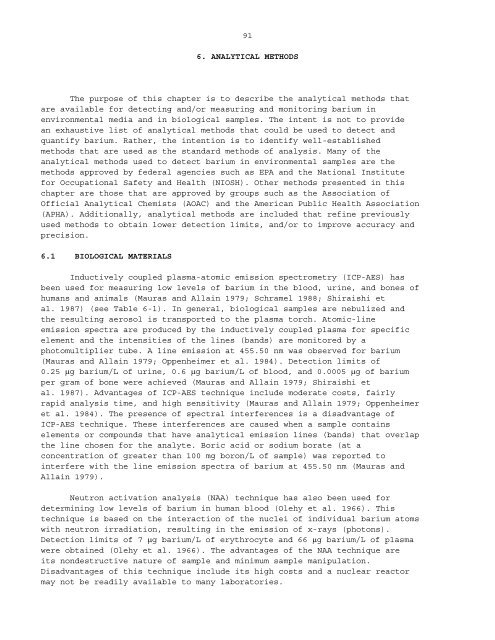TOXICOLOGICAL PROFILE FOR BARIUM AND COMPOUNDS ...
TOXICOLOGICAL PROFILE FOR BARIUM AND COMPOUNDS ...
TOXICOLOGICAL PROFILE FOR BARIUM AND COMPOUNDS ...
You also want an ePaper? Increase the reach of your titles
YUMPU automatically turns print PDFs into web optimized ePapers that Google loves.
91<br />
6. ANALYTICAL METHODS<br />
The purpose of this chapter is to describe the analytical methods that<br />
are available for detecting and/or measuring and monitoring barium in<br />
environmental media and in biological samples. The intent is not to provide<br />
an exhaustive list of analytical methods that could be used to detect and<br />
quantify barium. Rather, the intention is to identify well-established<br />
methods that are used as the standard methods of analysis. Many of the<br />
analytical methods used to detect barium in environmental samples are the<br />
methods approved by federal agencies such as EPA and the National Institute<br />
for Occupational Safety and Health (NIOSH). Other methods presented in this<br />
chapter are those that are approved by groups such as the Association of<br />
Official Analytical Chemists (AOAC) and the American Public Health Association<br />
(APHA). Additionally, analytical methods are included that refine previously<br />
used methods to obtain lower detection limits, and/or to improve accuracy and<br />
precision.<br />
6.1 BIOLOGICAL MATERIALS<br />
Inductively coupled plasma-atomic emission spectrometry (ICP-AES) has<br />
been used for measuring low levels of barium in the blood, urine, and bones of<br />
humans and animals (Mauras and Allain 1979; Schramel 1988; Shiraishi et<br />
al. 1987) (see Table 6-l). In general, biological samples are nebulized and<br />
the resulting aerosol is transported to the plasma torch. Atomic-line<br />
emission spectra are produced by the inductively coupled plasma for specific<br />
element and the intensities of the lines (bands) are monitored by a<br />
photomultiplier tube. A line emission at 455.50 nm was observed for barium<br />
(Mauras and Allain 1979; Oppenheimer et al. 1984). Detection limits of<br />
0.25 µg barium/L of urine, 0.6 µg barium/L of blood, and 0.0005 µg of barium<br />
per gram of bone were achieved (Mauras and Allain 1979; Shiraishi et<br />
al. 1987). Advantages of ICP-AES technique include moderate costs, fairly<br />
rapid analysis time, and high sensitivity (Mauras and Allain 1979; Oppenheimer<br />
et al. 1984). The presence of spectral interferences is a disadvantage of<br />
ICP-AES technique. These interferences are caused when a sample contains<br />
elements or compounds that have analytical emission lines (bands) that overlap<br />
the line chosen for the analyte. Boric acid or sodium borate (at a<br />
concentration of greater than 100 mg boron/L of sample) was reported to<br />
interfere with the line emission spectra of barium at 455.50 nm (Mauras and<br />
Allain 1979).<br />
Neutron activation analysis (NAA) technique has also been used for<br />
determining low levels of barium in human blood (Olehy et al. 1966). This<br />
technique is based on the interaction of the nuclei of individual barium atoms<br />
with neutron irradiation, resulting in the emission of x-rays (photons).<br />
Detection limits of 7 µg barium/L of erythrocyte and 66 µg barium/L of plasma<br />
were obtained (Olehy et al. 1966). The advantages of the NAA technique are<br />
its nondestructive nature of sample and minimum sample manipulation.<br />
Disadvantages of this technique include its high costs and a nuclear reactor<br />
may not be readily available to many laboratories.
















